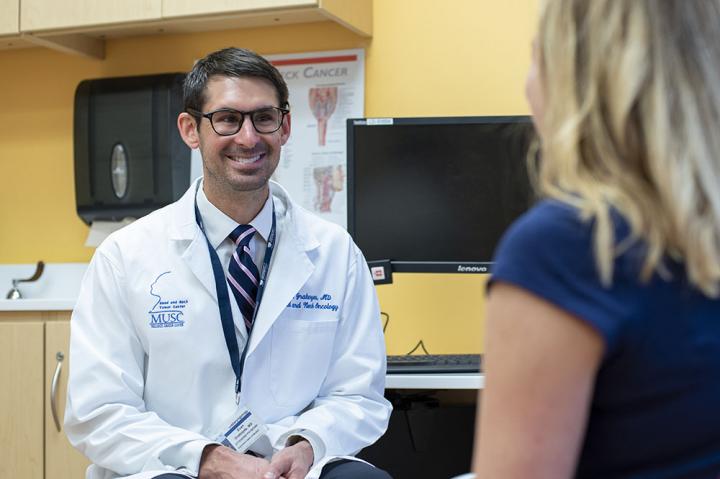MUSC Hollings Cancer Center researchers identify obstacles that prevent patients from receiving radiation treatment in a timely manner

Credit: Photo by Emma Vought; Medical University of South Carolina
In a recently published study in the Journal of Clinical Oncology – Oncology Practice, investigators from MUSC Hollings Cancer Center classify numerous barriers to a recommended therapy for head and neck cancer that may mean the difference between life and death for these patients.
Cancer of the head and neck is one of the deadliest cancers. Only half of those with head and neck cancer are alive five years following initial diagnosis. African Americans, in particular, experience worse survival outcomes. These patients are 50% more likely to die from the disease than white people, a concerning trend that has prompted deeper research into factors that might drive these significant disparities in head and neck cancer mortality.
The Hollings study team is led by Evan Graboyes, M.D., a surgeon scientist who is examining how to improve the timeliness and equity of care delivery to decrease head and neck cancer recurrence and improve survival. “The key measure of timely head and neck cancer care is the time between when patients get surgery and when they start their radiation. When people get their care within six weeks, it is less likely to recur. Unfortunately, we also know that nationally about half of head and neck cancer patients don’t get their radiation started on time, and that radiation treatment delays disproportionately burden African Americans.”
To understand more fully factors contributing to head and neck cancer treatment delays, Graboyes and his team conducted structured interviews with patients, providers, nurses, nurse practitioners, surgeons and radiation and medical oncologists across South Carolina. “It’s a qualitative study,” Graboyes explained, “where the key unit of analysis isn’t numbers but rather words and stories. Qualitative studies are really helpful for providing an in-depth understanding of experiences that patients, providers and other interviewees can offer us.”
Multiple levels of barriers
What makes this issue complex is that there are multiple obstacles that interact to prevent a patient from getting radiation treatment in a timely manner. The researchers found those obstacles include:
- A lack of patient and provider education on national standards of care.
- Unexpected post-surgical complications that interrupted tight treatment timelines.
- Poor communication between medical teams.
- Burdensome travel requirements to see different specialists.
“One of the interesting things we found is that patients might experience several of these barriers, just at different points in time during their treatments,” Graboyes said. “Their difficulties were constantly evolving as they progressed through the cancer care continuum.”
The study presents a novel theory-driven conceptual framework that classifies common treatment hurdles. The categories include problematic individual behaviors of patients and providers (intrapersonal barriers); insufficient communication between patients, providers, and caregivers (interpersonal barriers); insufficient communication between disparate care teams (health care barriers); inefficiencies related to fragmentation of care across organizations (organizational barriers); and challenges in health care access (community-level barriers).
“Within the cancer care delivery research spectrum, we as cancer researchers have spent a lot of time trying to understand how and why people do or don’t participate in screening activities and then developing interventions to implement into health care systems to help address those determinants,” he said. “There is a much less concerted effort and less scientific progress in trying to understand how the actual cancer care delivery itself happens. That’s why I think this research really is exciting.”
Beyond the study
Graboyes hopes that their model will facilitate future head and neck cancer interventions that target treatment barriers at one or more levels. “We know a lot about who is at risk for experiencing treatment delays, but before this study, we didn’t really understand why,” said Graboyes. “What this study does is give us a framework, a vocabulary and an understanding of how to relate these themes together in future quantitative studies.”
Graboyes credits the resources of the Hollings Cancer Control Research Program; the expertise of his team, including center members Chanita Hughes-Halbert, Ph.D., Katherine Sterba, Ph.D., Hong Li, Ph.D., and Graham Warren, M.D., Ph.D.; and the outstanding multidisciplinary head and neck oncology group as being critical to the success of the study.
“Hollings Cancer Center has been a major enabler of this research where we are trying to understand cancer care delivery across the state, with a specific focus on the racial minority patient population and the challenges they face.”
Next, Graboyes intends to test whether an intervention strategy funded by the National Cancer Institute, referred to as NDURE (Navigation for Disparities and Untimely Radiation thErapy), can improve patient outcomes. A major feature of this intervention will be the role of an assigned navigator who will work with head and neck cancer patients to create a tailored and dynamically evolving plan based on which barriers they are experiencing. A patient and referral tracking system also will be employed to check on the patient’s progress across health care systems, remind them of upcoming appointments and help to identify needed travel resources to keep care timelines on track.
Graboyes anticipates that his conceptual framework will facilitate novel intervention strategies for other cancers besides head and neck cancer. “There are many other cancer types besides head and neck cancer that are treated with multimodal, sequential cancer treatment paradigms. The work we are doing, trying to understand the determinants of head and neck cancer, certainly can benefit other cancers with similar care delivery challenges.”
###
About MUSC
Founded in 1824 in Charleston, MUSC is the oldest medical school in the South, as well as the state’s only integrated, academic health sciences center with a unique charge to serve the state through education, research and patient care. Each year, MUSC educates and trains more than 3,000 students and nearly 800 residents in six colleges: Dental Medicine, Graduate Studies, Health Professions, Medicine, Nursing and Pharmacy. The state’s leader in obtaining biomedical research funds, in fiscal year 2019, MUSC set a new high, bringing in more than $284 million. For information on academic programs, visit musc.edu.
As the clinical health system of the Medical University of South Carolina, MUSC Health is dedicated to delivering the highest quality patient care available, while training generations of competent, compassionate health care providers to serve the people of South Carolina and beyond. Comprising some 1,600 beds, more than 100 outreach sites, the MUSC College of Medicine, the physicians’ practice plan, and nearly 275 telehealth locations, MUSC Health owns and operates eight hospitals situated in Charleston, Chester, Florence, Lancaster and Marion counties. In 2019, for the fifth consecutive year, U.S. News & World Report named MUSC Health the No. 1 hospital in South Carolina. To learn more about clinical patient services, visit muschealth.org.
MUSC and its affiliates have collective annual budgets of $3.2 billion. The more than 17,000 MUSC team members include world-class faculty, physicians, specialty providers and scientists who deliver groundbreaking education, research, technology and patient care.
About MUSC Hollings Cancer Center
MUSC Hollings Cancer Center is a National Cancer Institute-designated cancer center and the largest academic-based cancer research program in South Carolina. The cancer center comprises more than 100 faculty cancer scientists and 20 academic departments. It has an annual research funding portfolio of more than $44 million and a dedication to reducing the cancer burden in South Carolina. Hollings offers state-of-the-art diagnostic capabilities, therapies and surgical techniques within multidisciplinary clinics that include surgeons, medical oncologists, radiation therapists, radiologists, pathologists, psychologists and other specialists equipped for the full range of cancer care, including more than 200 clinical trials. For more information, visit http://www.
Media Contact
Heather Woolwine
[email protected]
Original Source
https:/
Related Journal Article
http://dx.




